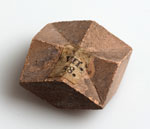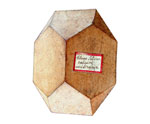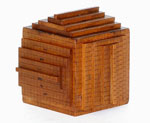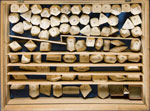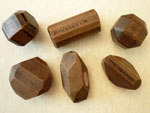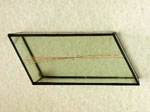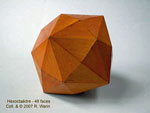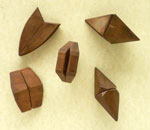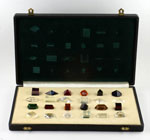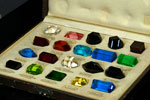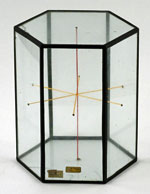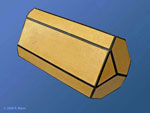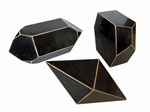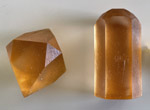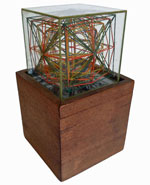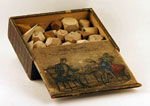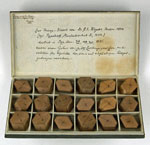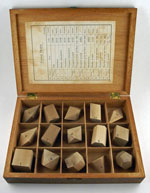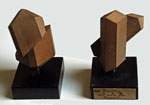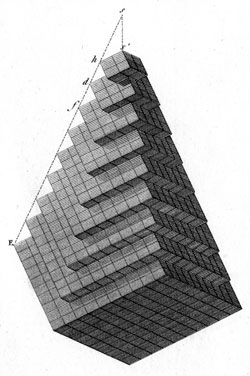Early Crystal Models
click images for more informationRomé de L'Isle, terracotta models
Collection of 395 small (ca 3 cm) terra cotta models. The models were bought in Paris in 1785 by Martinus van Marum, the first director of the Teylers Museum in Haarlem, the Netherlands. The complete collection still resides in the museum.
The models were made by Romé de L’Isle’s coworkers Arnould Carangeot, Lhermina and Swebach-Desfontaines in order to stimulate the sales of the expensive 4 volume set of his book "Cristallographie" (1783).
Haüy wooden crystal models
Collection of pear wood models (sizes between ca 2.5 and 10 cm). Each model is labeled mentioning the name of the crystal form. Between 1802 and 1804, Martinus van Marum, the first director of the Teylers Museum in Haarlem, the Netherlands, bought 597 of these pear wood models. Today 565 of these are still present in the museum, making this set the most complete collection of Haüy crystal models that still survives.
René Just Haüy introduced wooden crystal models to illustrate the two-dimensional drawings in the atlas volume of his "Traité de Minéralogie" (1801).
Wooden model illustrating Haüy's laws of decrement on the edges
The model represents Haüy's theory of how the dodecahedron with pentagonal faces (pyritohedron) is constructed from a cubic nucleus by decrement of two rows of "integrant cubic molecules" of each newly added layer on two opposite edges combined with a decrement of only one row of molecules on every two successive layers on the other two edges. This combination takes place in three perpendicular directions.
The model whose edges show 17 cubic "molecules" fits exactly the illustration in the atlas of Haüy's "Traité De Minéralogie" (1801).
Wooden model illustrating Haüy's laws of decrement on the edges and vertices
The model illustrates a complex differential decrement of cubic "molecules" on the edges AND on the vertices. It results from a combination of Haüy's laws giving the octahedron starting from the cube combined with that giving the pyritohedron and exemplifies crystal forms of pyrite ("sulfure de fer icosaèdre" of Haüy).
Haüy R.J. Annales de Chimie, 17, 225-319 (1793).
L. v. Rössler plaster crystal models
Plaster models in a wooden box. The wooden box (39 x 29 x 8 cm) contains two trays; one with models illustrating the combination of forms and one with models of twinned crystals. The models are numbered and some of their faces bear Naumann symbols. The numbers relate to a booklet describing the forms present on each model. The accompanying booklet indicates that the models were made by L. v. Rössler and refers to the crystal systems of Mohs and Naumann.
P. Groth & F. Krantz collection (1880)
6 silver- and/or gold-containing minerals. From left to right:
top row: stephanite (392), krennerite (394), hessite (47)
bottom row: sylvanite (533), proustite (215) and freislebenite (539).
F. Krantz glass crystal model (ca. 1900?)
A small glued label indicates: "I | Dr. F. Krantz | Bonn a. Rh."
Internal silk threads materialize the crystallographic axes and illustrate with the corresponding colours the dispersion of the optic axes and of the acute bisectrix for blue, yellow and red light.
F. Krantz wooden crystal model of an hexoctahedron
F. Krantz collection (1880)
From left to right:
top row: gypsum (564), lazulite (589)
center: trydymite (711)
bottom row: titanite (702), calcite (307)
Libotte wooden crystal models, ca. 1841
Porcelain crystal models (ca. 1841)
The models are not signed, but the material they are made of and the stamped letters P, M, T are typical for models made by John Joseph Griffin (ca. 1841)
Colored glass crystal models
Unsigned, first half 20th century.
Colored glass crystal models
Unsigned, likely Czechoslovakia, late 19th early 20th century.
Krantz glass crystal model
Internal silk threads materialize the crystallographic axes; red for the c-axis, yellow for the other axes.
On the tetragonal crystal model a small glued label indicates: "16 | Dr. F. Krantz | Bonn a. Rh." On the hexagonal crystal there is a similar label indicating: "10 | Dr. F. Krantz | Bonn a. Rh.", and another gilded label with the Krantz logo and the text "Dr. F. Krantz | Bonn am Rhein".
Both models, first half 20th century.
F. Krantz cardboard crystal model
A small glued label indicates: "25 | Dr. F. Krantz | Bonn a. Rh.", first half 20th century.
Set of Bakelite crystal models
First half 20th century.
Set of plastic casts of crystal models
19th century glass and wire model
The maker is unknown.
Case with wooden crystal models
Ca. 1860.
Wooden models of twinned feldspar crystals
G.E. Kayser, Berlin, 1834.
On the occasion of his inauguration in 1834, Gustaf Eduard Kayser (1803-?) presented this set of wooden crystals to Christian Samuel Weiss (1780-1856) who was professor at the University of Berlin.
Case with wooden crystal models
Unsigned, mid 20th century.
Wooden crystal models from Germany or Austria
82 loose wooden bases (most of them with a label) are also present. The back of two detached labels bears "K. K. Staatsgymnasium Wien I."
End 19th century.
